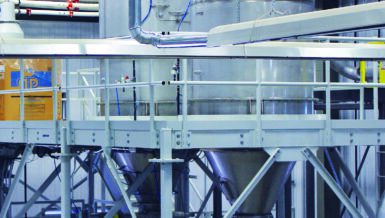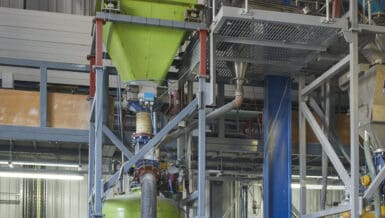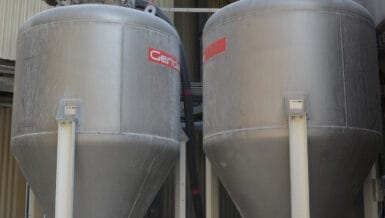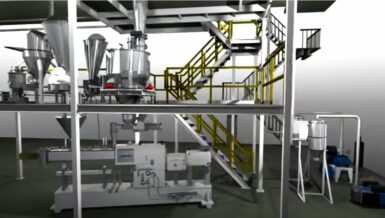What is air velocity?
Also known as conveying airspeed, air velocity is the speed at which air flows through pneumatic conveying pipelines.
If your system fails to reach the minimum air velocity required to move your product from beginning to end, your pipes will become blocked. But if your air velocity is set too high, the excessive force can damage your product, reducing its quality and your salable quantity.
Air velocity changes throughout your conveying lines, and is affected by pressure and temperature. As pressure decreases along the line, volumetric flow rate and conveying air velocity increase.
Pressure drops in pneumatic conveying systems correlate to the square of the air velocity. Therefore air velocity must be kept at the minimum acceptable levels to prevent unexpected pressure drops and convey your product effectively.
What is the correct air velocity for my system?
Each pneumatic conveying system requires a different air velocity depending on the type of system, its design, and the materials it transports. But as a rule of thumb, the end-of-line air velocity of common conveying lines are typically as follows:
- Dilute phase pressure systems – 20-25 m/s (3,900-4,900 ft/min)
- Dilute phase vacuum systems – 20-30 m/s (3,900-5,900 ft/min)
- Dense phase pressure systems – 4-8 m/s (800-1,600 ft/min)
- Dense phase vacuum systems – 5-10 m/s (1,000-2,000 ft/min)
Since air velocity changes across the length of pipelines, you must calculate its value based on a specific reference point. To calculate air velocity, divide volumetric flow rate in m3/s by the passing length of the pipe in m2.
How does air velocity affect materials in the system?
The effect of air velocity on your materials differs depending on their particular characteristics. By familiarizing yourself with your particular product, you can optimize the air velocity in your system.
Size
Materials with fine, granular particles require higher air velocities, typically between 13-15 m/s (2,600-3,000 ft/min). However, the correct velocity is also affected by the width of the particle size distribution. Materials like granular sugar have a narrow size of particle distribution, and so require slightly higher air velocities of around 16 m/s (3,150 ft/min).
Shape
Dry bulk materials with large surface areas typically require a lower air velocity. Cement, for example, requires an air velocity of around 10-11 m/s (2,000-2,200 ft/min). Fly ash, on the other hand, which has a more spherical shape, requires an air velocity of around 11-12 m/s (2,200-2,400 ft/min).
Weight and density
If the air velocity in your pneumatic conveying system is too low, there won’t be enough force to move your material through the pipeline. This can lead to blockages and pressure loss, which require downtime and maintenance expenses to fix.
Larger material particles with higher densities require higher air velocities to transport. But moving lighter materials through your pipelines at high speeds can cause them to degrade. Finding the correct air velocity for your system and materials lets you process them quickly while keeping particle damage to a minimum.
Material dusting and abrasion
When hard materials are conveyed at excessive speeds, they’re at risk of shattering. This not only reduces the quality and profitability of your product, but can also lead to greater abrasive wear and blocking.
Materials that are both hard and glass filled, such as nylon or polypropylene, can also cause serious abrasive wear when conveyed at high velocities. That means your components will wear out more quickly, increasing your maintenance expenses.
Angel hair
Angel hair, also called streamers, refers to long, thin strings of plastic created within pneumatic conveying lines. They often occur when plastics are conveyed at excessive air velocities, generating high frictional heat and abrading against pipe walls. As well as damaging the product itself, angel hair can also cause color contamination and clog filters, which lead to unnecessary downtime.
5 tips for optimizing air velocity in your pneumatic conveying system
- Familiarize yourself with the properties and characteristics of the material you convey. That includes the size, size distribution, shape, weight, and density of the particles. This will also help you calculate the correct acceleration length of your pipes, letting your material reach its terminal velocity as quickly as possible.
- Calculate the solids loading ratio to determine how much material there is in the air. This will help you figure out the minimum required air velocity.
- Avoid excessive air velocity, as this could damage your materials. Minimum conveying velocity is typically set at least 20% higher than saltation velocity to ensure efficient conveying without excessive costs.
- Design your system with straight pipes between the elbows. That way, your materials can be picked up in the air stream and gain velocity as they move.
- Install sensors that monitor airflow and allow you to control air velocity more effectively for the material being conveyed.










































